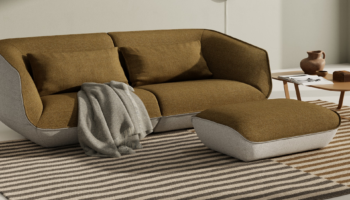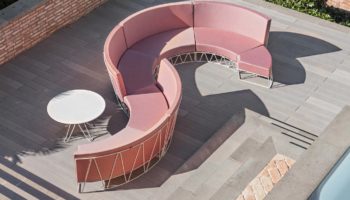Party Lounge
Just the other day, as my fiance© and I were straightening out our office/guest room-a space with a couch/futon that requires just way too much effort to effect the couch-bed transformation-I remarked that someone should make a sleeper sofa that was actually comfortable and practical. And by this I meant (mean) a real bed that invites sleep: no absurd metal bar under the trim-mattress to attack the spine; no crazy creaking and groaning with every turn of the sleeper; no straining of back or groin to manipulate the thing. Turns out Frederick Kiesler was well ahead of me. In 1936, as an element of his ensemble for the Mergentine apartment in New York, Kiesler created the Party Lounge, a transformable bed/lounger on wheels with a simple steel tube under structure and handsome upholstery in quilted naugahyde. The main difference between this piece and a traditional sleeper, however, is also the Party Lounge’s pièce de r©sistance-only the central section of the backrest folds up.
Party Lounge. Designed by Frederick Kiesler. Manufactured by Wittmann Möbelwerkstätten, Austria.
The innovation both creates a new style of seating and gives the piece its vaunted versatility. It’s true, perhaps, that this versatility is somewhat constrained by the lounge’s dimensions (80″ by 50″), but I prefer to think of this quality as an incentive to innovative arrangements. Besides, the large profile prevents the temptation to back the piece up to the wall or squish it into a corner. Manufacturer Wittman, who released a re-edition in 2002, has its own take on potential uses: “The term Party Lounge, registered as a patent by Friedrich Kiesler in 1936, is something of a declaration of intent, as the sofa has room for up to six people-enough for a party.” Looking at the piece confirms this vision-especially in regard to the place and the time: I can see it in a spacious and modern 5th. avenue loft, its quilted contours flanked by notable New Yorkers like Dorothy Parker or Dashiel Hammett, the gin flowing, the repartee crackling, the Party Lounge the center of it all.

Installation view, Destory Athens. 1st Athens Biennale, 2007 (left). Untitled. Oil on canvas, 2007 (right).
But the saga of Kiesler’s creation does not end there. Early this year, Norweigan artist Bjarne Melgaard re-upholstered several of the Loungers with fabrics of his own design and presented them as part of an exhibition at the Greene Naftali Gallery in NY: “A series of couches designed by Josef Hoffman and Friedrich Kiesler (produced by Wittmann Möbelwerkstätten, Austria) with fabric designs by Melgaard (and produced at Backhausen, who made fabric for the Wiener Werkstätte). Adorning the surfaces of these disparate mediums is an unlikely m©lange of recirculating tropes: monsters, elephants, men standing in line, chihuahuas, ghosts, male odalisques, and repeated phrases such as “Ben Gazzara,” “snuff cubes,” and “gay mafia.”
Melgaard’s use of an old form to give new dimensions to contemporary art is perhaps the ultimate tribute to Kiesler-a testament to an aesthetic allure and an enduring vision.




Leave a Reply